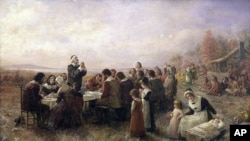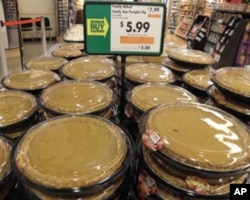On Thursday, Nov. 24, Americans mark our annual Thanksgiving holiday. It often revolves around a lavish dinner for family and friends that begins with a prayer of thanks for our blessings. The Thanksgiving tradition is modeled after harvest-home feasts - especially what’s been called the “First Thanksgiving” in colonial Massachusetts.
It’s the pleasant story of a cold, late-fall day in 1621, when about 50 pious English settlers called “Pilgrims,” who had barely survived their first year in the New World, shared a feast with their neighbors, the friendly Wampanoag Indians.
But according to curators at Plimoth Plantation - a living-history museum in the same settlement where the Pilgrims and Indians marked that harvest almost 400 years ago - the Thanksgiving story is more fable than fact.
Thanksgiving prayers
We associate solemn prayers of thanks to God with the holiday, and many American families that don’t usually say grace before meals pause to give thanks before eating on Thanksgiving.
But there wouldn’t have been many prayers at that crude festival 390 years ago. The pious Pilgrims would not have included people they considered pagan nonbelievers in solemn prayers, and the Indians likely would not have joined in praying to one all-powerful God.
Turkey time
Plump, domesticated turkeys are the centerpiece of the Thanksgiving table today.
But while the skimpy records from 1621 mention fowl, these were likely geese and ducks in the oceanfront Plymouth community. If they were turkeys, they’d have been the scrawnier wild variety.
Pumpkin pie
Our holiday tables are virtual groaning boards, crowded with a variety of dishes. And most illustrations of the First Thanksgiving also show tables piled high with breads and pumpkin pies.
It’s an unlikely scenario.
The Pilgrims had neither the sugar nor the wheat flour and ovens needed to make such baked goods.
Not-so-deep friendship
Sketches depicting the Plymouth Thanksgiving show a pleasant, if not outright joyful sharing between the Pilgrims and their good friends, the Indians.
It’s an unlikely historical rewrite.
Things were suspicious and tense between them, and their alliance would devolve into fighting and bloodshed 50 years later.
Pilgrim fashion
Thanksgiving images are replete with Pilgrims in fine coats, shiny shoes, and tall hats with big buckles above their wide brims. And some show the Indians in colorful garb. Definite embellishments.
The struggling Pilgrims wore beaver hats and deerskin coats. After the rough first year they had endured, they were likely thankful to have any clothes, and to have lived to wear them.
The Wampanoags, too, wore simple deerskin and one or two feathers, not the colorful headdresses of the Plains tribes a century later.
Not even the first
OK, so we’ve polished the tradition a little. But at least the Pilgrims’ get-together with the Wampanoags in 1621 was the First Thanksgiving, right? Not everyone agrees.
Twenty-three years earlier, Spanish explorer Juan de Onate held a huge thanksgiving celebration on the banks of the Rio Grande River after leading settlers on an arduous, 563-kilometer trek across the Mexican desert.
And in 1619, two years before the Pilgrims and Indians shared food together, a ship carrying 38 settlers landed at Virginia’s Berkeley Planation. These newcomers and existing settlers threw a party, and the London company that sent them ordered that the date be marked with an annual Thanksgiving celebration every year thereafter.
That earlier Thanksgiving is marked at the Berkeley Plantation each year.
Hardly rock solid
A big rock on the dock in Plymouth, Massachusetts, has been fenced in and labeled “Plymouth Rock.” Now a famous tourist attraction, it’s said to be the place where the pilgrims first came ashore in the New World. Wrong again.
According “Saints and Sinners,” a trusted book published in 1945 by George Willison, who devoted his life to studying the Pilgrims, their ship, the Mayflower, didn’t dock first anywhere near there.
They first set foot in North America to the north, at what is now Provincetown on Massachusetts’ Cape Cod. And when William Bradford and his fellow Pilgrims did come ashore in what they would call Plimoth shortly thereafter in 1620, it was all along the beach, not on a particular rock. Over time, the town that grew up around it was Plymouth.
The whole episode, George Williston wrote, was a fabrication - a fable and public relations stunt. Plymouth Rock wasn’t even mentioned until an old man told the story 121 years after the so-called First Thanksgiving.
None of this, of course, prevents stores from selling Pilgrim outfits and dolls, cornucopia displays, and, of course, fat, butter-basted turkeys that Americans by the millions roast, carve, and enjoy on Thanksgiving Day.














